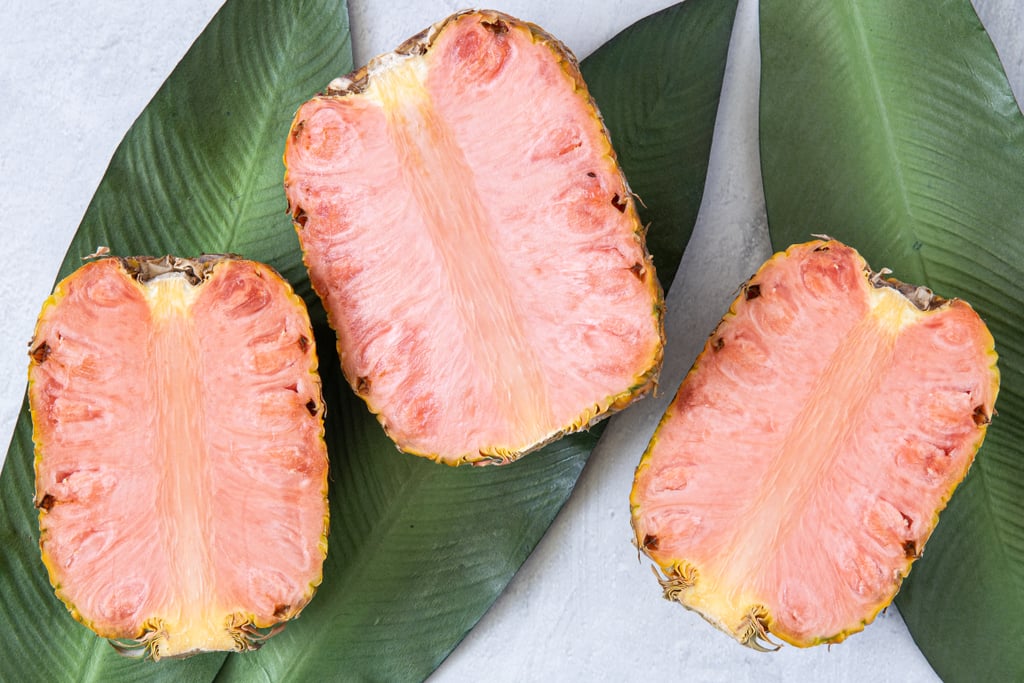Pink Pineapple - What The Fruit??

What is a Pink Pineapple Fruit?
Pink pineapples are genetically modified fruit that stay pink and sweeter than yellow pineapples. GMOs, or genetically modified organisms, are crops produced using a precise method of plant breeding to achieve desirable traits. Desirable traits include resistance to pests or non-browning produce to reduce food waste. In this case, the desirable traits of the pink pineapples include sweetness and its deep pink color.
Why are GMO Pink Pineapples a Thing?!
Food and agricultural companies are always researching new ways to produce crops that have environmental and consumer benefits. Del Monte created the Rosé Pineapple, a genetically modified pink pineapple fruit, to introduce a new and exciting produce. They’re also sweeter, so pineapple fans can enjoy an even more delicious variety of their favorite fruit.
The patent for the PinkGlow™ Rosé pineapple states that the main objective of this invention was to produce a unique and differentiated variety of pineapple. There’s no telling how much interest in pineapples this new fruit will generate.
What Makes a Pink Pineapple Pink?
Scientists turned pineapples pink by changing a small enzyme that controls the color of the fruit’s flesh. An enzyme is a substance that creates a specific biochemical reaction. In this instance, typical yellow pineapples have high levels of enzymes that change the pink pigment, called lycopene, into a yellow pigment, called beta carotene. To make the pineapple pink, scientists reduced that particular enzyme, so the pineapple stays pink, instead of turning yellow.
Beta carotene might sound familiar. This yellow and orange pigment is also found in carrots and other colorful vegetables. Lycopene is the same pigment that turns tomatoes red and watermelons pink. Pigments are like the edible dyes of the plant world. The higher the concentration, the darker the color.
Because these pigments are only active in the inside flesh of the fruit, there is no impact on the exterior skin of the pink pineapples. So if you see any pictures of pineapples with pink skin on the outside, instead of brown or tan, you’re most likely looking at a bad Photoshop.
Are Pink Pineapples Safe to Eat? What are Pink Pineapple Health Benefits?
The pink pineapple plant is just as safe and nutritious as its conventional counterpart. That’s because the genetic modification only changed three genes in the pineapples -- none of which affect the safety or nutrition of the fruit.
The researchers started with the Del Monte Gold Pineapple. Using this as the “parent” fruit, they continued to breed and select the fruits with pinker flesh on the inside. Researchers then used genes from other pineapples and tangerines to suppress the expression of carotene, so more lycopene builds up in the pineapple’s interior flesh. Lycopene is a red pigment, which is why the build-up of this substance results in a pink pineapple. These genes were derived from safe and edible plants; and are still safe and edible when expressed in the pink pineapple.
Scientists also made two minor changes the plant’s skin and growth cycle. The exterior shell of the plant was slightly modified to have a unique pattern. Lastly, researchers modified a gene that controls the pineapple’s growth cycle. That change will help provide a more uniform and higher quality crop.
When Did Pink Pineapples Hit Our Shelves?
The pink PinkGlow™ pineapple hit the shelves in the United States in late 2020. As with all genetically modified (GM) foods, the fruit has been on a long regulatory journey. Pink pineapples have been thoroughly researched for human and environmental safety.
Del Monte first began developing the genetically modified pink pineapple in 2005. Pink pineapples were researched and are grown in Costa Rica. The Costa Rican government first approved the planting of pink pineapples in 2011.
Genetically modified crops take years of research, testing, and development. This ensures they’re safe for human consumption and the environment. At this time, Del Monte has only pursued regulations and approvals for pink pineapples in the United States and Costa Rica.
In 2012, Del Monte submitted a request to the United States Department of Agriculture (USDA) to test and import the Rosé Pineapple from Costa Rica to the United States. The USDA approved this request in 2013 [PDF]. The USDA was not concerned about pink pineapples’ impact on the environment. Pineapples have a hard time growing without help from humans, so it’s unlikely they will spread on their own.
Most recently, the U.S. Food and Drug Administration (FDA) evaluated Del Monte’s pineapple in 2016. They determined that pink pineapples are as safe and nutritious as their conventional counterparts. This consultation with the FDA wasn’t required. Instead, it was a voluntary activity to assure consumers that this new fruit is safe and nutritious.
- - -
Photo credit to and source: Fresh Del Monte


